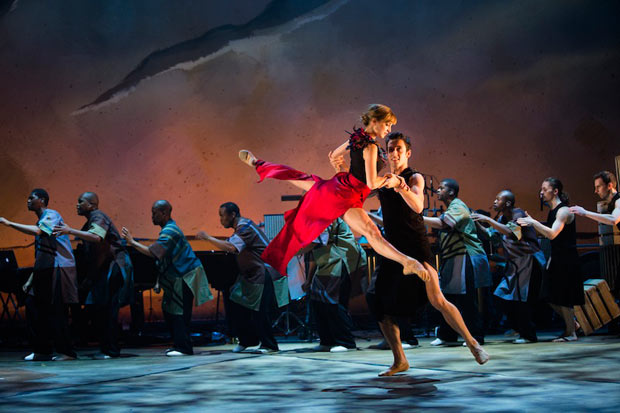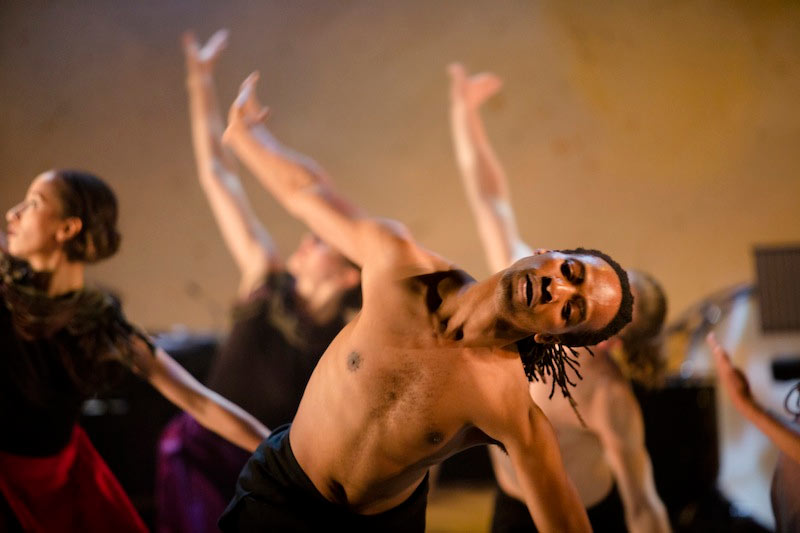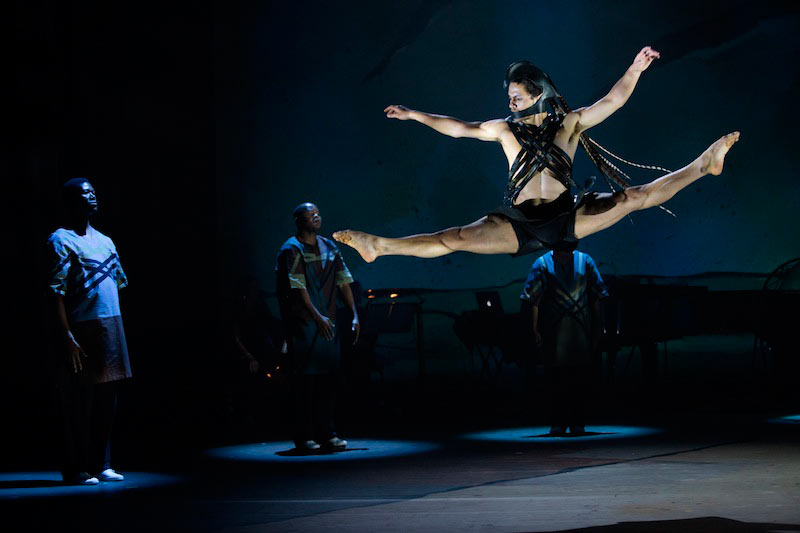
© Giulietta Verdon-Roe. (Click image for larger version)
Mark Baldwin & Ladysmith Black Mambazo
INALA
London, Sadler’s Wells
17 September 2014
inala.co.uk
www.sadlerswells.com
Ladysmith Black Mambazo accentuated the sad in Sadler’s Wells. There were moments in this performance when the hauntingly beautiful sound of this globally-acclaimed South African male choir seemed just too serene for the setting. And it is perhaps a little ironic that it was singers – and not dancers – that evoked such a tender emotional resonance in London’s dance house.

© Giulietta Verdon-Roe. (Click image for larger version)
The reason for Ladysmith Black Mambazo performing in a theatre devoted to dance goes back to a concert at the Cadogan Hall, in 2009, when two young women (the Royal Ballet dancer, Pietra Mello-Pittman and the composer, Ella Spira) conceived the idea of creating a spectacular visual presence to contextualise their songs. Thus, the idea of a Zulu ballet was born: the name Inala came subsequently, when Mello-Pittman saw the word written on a wall during her research in South Africa. It has two meanings: one is “harvest to reap” in the sense of preparation to create reward; and the other is an “abundance of goodwill”. That all of this sentiment is packed into a five-lettered word seems an especially apt cipher for the glorious simplicity of this production: and one that is iced by the extra pun of “a-bun-dance” in defining the translation of a title for a ballet.
A long development period saw the Ladysmith Black Mambazo singers experience classical ballet for the first time – surreally watching a performance of The Nutcracker at The Royal Opera House – and involved the Royal Ballet’s South-African born director, Dame Monica Mason, for whom the choir evoked nostalgic memories of workers singing their Zulu harmonies on her father’s Ladysmith farm.
Inala is produced around a structure of some 18 songs, each of which has its own microcosm of narrative, knitting loosely together to tell the story of a failed marriage. One early song (Eza Malobolo) relates that the young man has found “a nice lady” and wants to pay a dowry in cattle so that he can marry her. But, four songs later – in Inhilizyo Yami Ibuhlingu – the bride has gone leaving the man broken-hearted. Back-to-back songs in the second act (Zombuya Nini Na and Zobuya) speak of the demand for her family to pay the livestock back because the bride “has failed”! But, thankfully Inala ends on a more uplifting sentiment with three songs that emphasise the solace and beauty of home, expressing the hope of farewell that “we will see each other again” (Siyophinda Subonani). These beautiful songs and the nine singers of Ladysmith Black Mambazo are unquestionably the heart and soul of Inala and the show would have worked very well without any extra effort. But, to what extent did the young producers achieve their vision of adding value to the visual context?

© Giulietta Verdon-Roe. (Click image for larger version)
The first attempt to establish a balletic interpretation of these Zulu songs failed because the choreography was apparently deemed to be too classical and it was then that the Rambert artistic director, Mark Baldwin, was brought on board. Baldwin has used the formative influences of tribal dancing from his native Fiji to infuse a neo-classical ballet language with movement essentially focused on the hips, the weight thrust down onto bent knees and although Royal Ballet dancer, Camille Bracher –in particular – has plenty of opportunity to raise her legs to the stars, there is not an abundance of airborne movement. The best of the specialist dancing comes whenever Mbuelo Ndabeni and Dane Hurst are on stage (perhaps too infrequently) since they provide a seamless extension to the Mambazo cast, moving with the same inimitable sway.
This show was at its best when the dancers and singers (nine of each) were one single harmonious unit at which time the rhythmic movement of the choir was indistinguishable from the professional dancers. The Ladysmith singers – with an age range of almost 50 years – possess an intuitively beautiful movement style, which Baldwin uses either as an integral element of his own choreography or as a means with which to frame the dance. His fusion of movement styles is extraordinarily well done and sits very effectively on the simple, yearning sadness of the music, a joint effort by Spira with the Ladysmith Black Mambazo’s founder and musical director, Joseph Shabalala, and other members of the choir (five of the nine hails from the Shabalala clan). Sound designer, Adrian Rhodes has added the effective filmic quality of an African soundscape as continuity in linking the songs. Some dancers occasionally wear beautiful Trojan-style masks with long tail feathers, designed by Georg Meyer Wiel, adding more tribal resonance to enrich even further the completeness of this visual Out of Africa landscape.

© Giulietta Verdon-Roe. (Click image for larger version)
Occasionally, I found myself wanting more of the Ladysmith singers and – Hurst and Ndabeni excepted – less of the dancers taking centre stage but these were minor considerations set against an overall production that had such significant emotional power; enchantingly sentimental in its elegant simplicity. Mello-Pittman and Spira (trading under the production title of the Sisters Grimm) have translated their vision from the stalls of the Cadogan Hall into the realisation of an astonishing debut project that does indeed achieve a rich visual spectacle to enhance the most gorgeous music, sung uniquely. They have reaped an abundant harvest and Inala is set to be a runaway success.

















You must be logged in to post a comment.